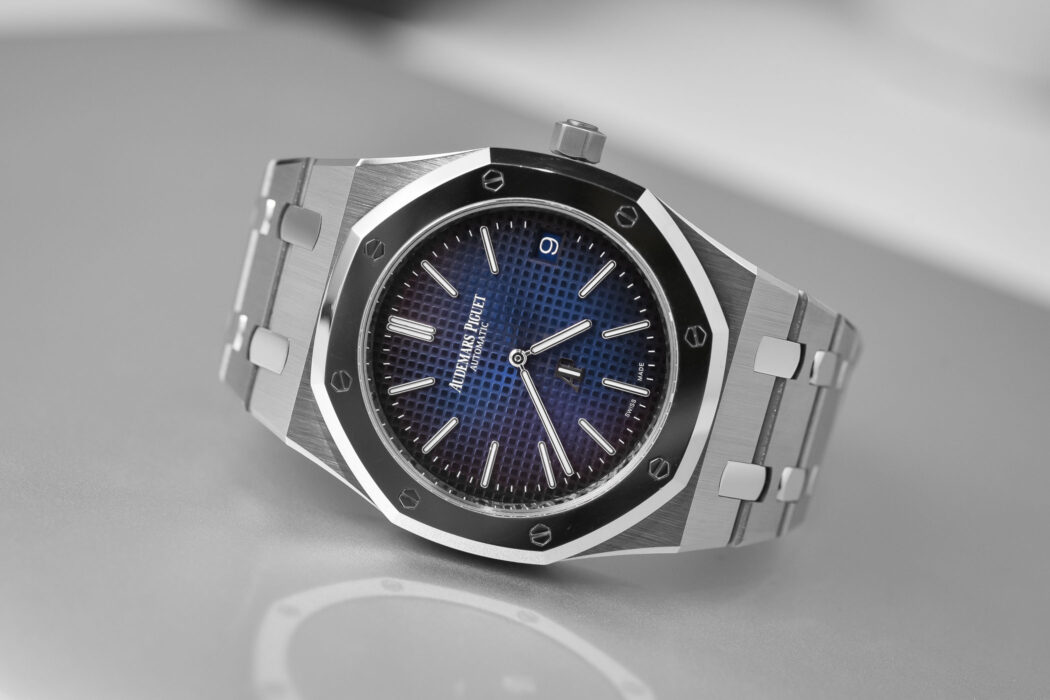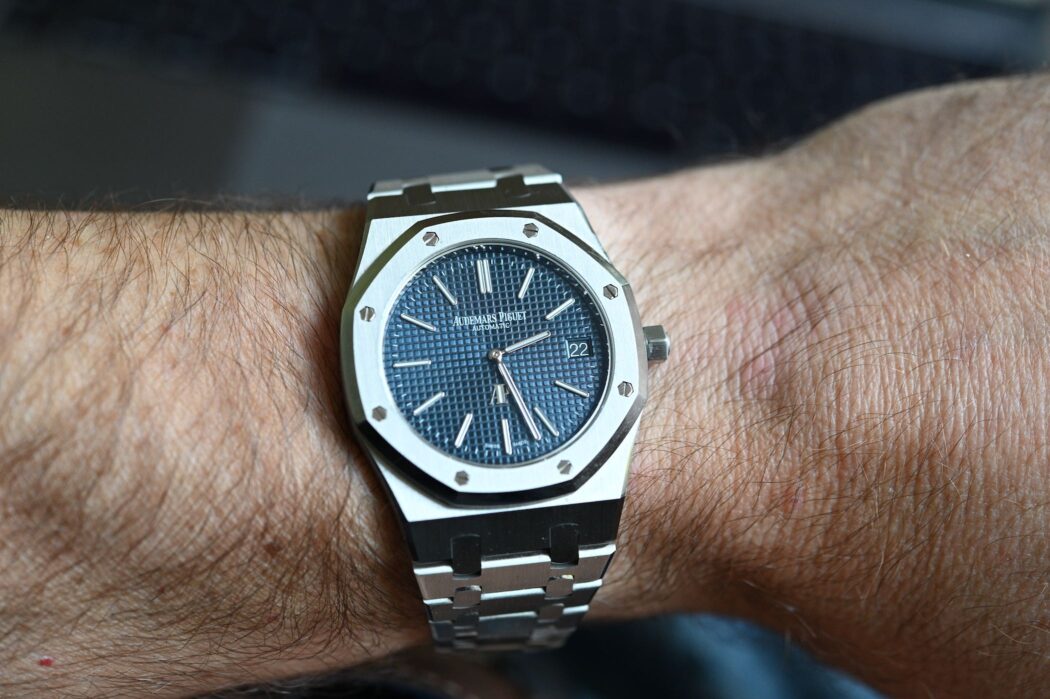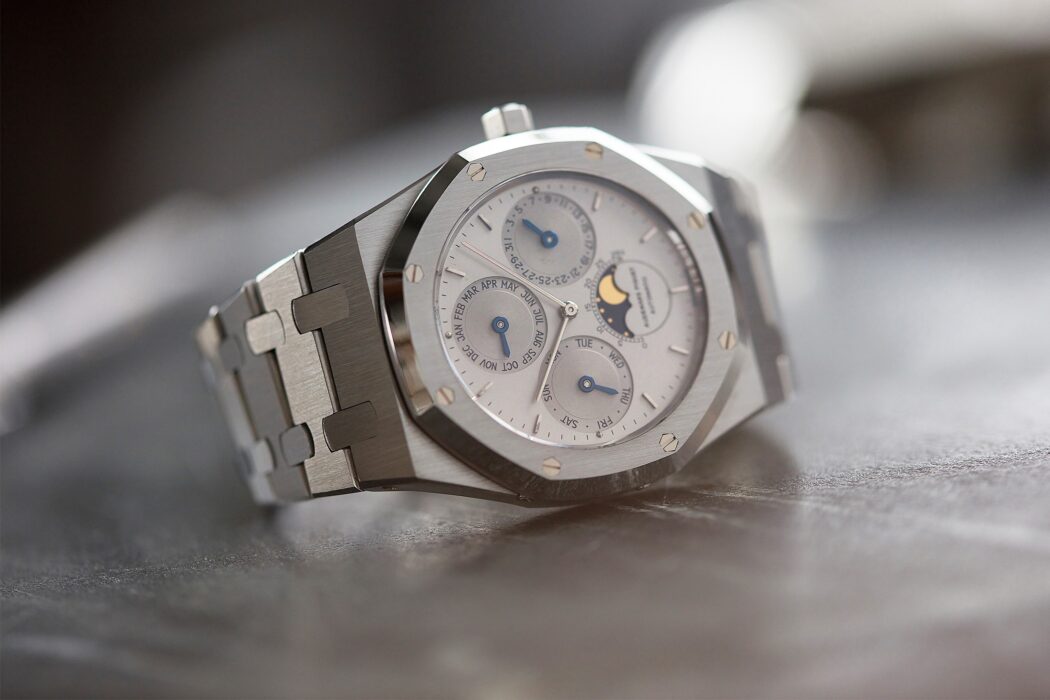Take a look back at one of today’s most coveted watches.
How do you define a “sports watch?”
In a nutshell, a “sports watch” is one that is worn while playing sports. It should be something robust, not too heavy, highly legible, and not too expensive. In case you beat it to hell while playing.

Until the early 1970s, when the Quartz Crisis hit, and the cheap battery-powered Japanese quartz movement overtook the mechanical movement around the world, (almost) rendering mechanical watches obsolete.
A storied Swiss watchmaker such as Audemars Piguet, founded in 1875, had no idea how to compete with such cheap, easy-to-produce, and dare we say throw-away technology. For those who are counting, AP produced so few chronographs during the 20th century—just 307 between 1930 and 1962—that it did not issue reference numbers. Even if it was a simple, time-only sports watch, such a brand would not be able to produce reams of cheap timepieces to compete with the Japanese brands.
However, it could take the opposite approach.
Would you buy a “luxury” sports watch? Would you buy a watch that was so refined that customers were compelled as if by magnetism, to buy it rather than a cheap, battery-operated watch?
Gérald Genta turned out to be the answer. In the past, the Swiss industrial designer had designed watches for Universal Genève and Omega. He was selected as Audemars Piguet’s first “luxury sports watch.” According to Genta, the brief was straightforward: AP’s managing director George Golay called him at 4 p.m. on April 10th, the night before Swiss Watch Show (later “Baselworld”) and said, “Mr. Genta, we have a distribution company that has asked us for a steel sports watch that has never been done before—and I need the design sketch for tomorrow morning.” (In fact, it was three SIHH executives who dreamed up the idea of a luxury steel sports watch. They were helping Golay expand AP’s reach. The distribution company was the SSIH, Société Suisse pour l’Industrie Horlogère. George Golay had the vision to take up their challenge..)


Genta came up with a completely original idea.
For one, Genta eschewed the traditional round shape of contemporary timepieces in favor of a tonneau-shaped case with an octagonal bezel inspired by—or so Genta recalls—deep-sea divers’ helmets. There are eight octagonal screws visible, further suggesting the aquatic theme, if you pay attention. This design is complemented by a unique, integrated bracelet (which, by the way, is extraordinarily difficult to machine) and a dial executed in a petite tapisserie motif, giving it a dynamic look lacking in many other sports watches. As for the name, Royal Oak is a series of eight British Royal Navy vessels.)
When Genta released his watch at the Swiss Watch Show in 1972, it wasn’t immediately a success. At 3,300 Swiss francs, it was many times the price of a contemporary Rolex Submariner, with exposed screws, an octagonal bezel, and an integrated bracelet. Even a simple gold dress watch from Patek Philippe was more expensive than it was.
It wasn’t long before people started to take notice. “The world’s most expensive stainless steel watch,” a campaign ran in the American market. “You need more than money to wear a Royal Oak,” went another. The fact that it was wildly expensive was not a deterrent. (The best? “Would you buy a Rembrandt just to see its canvas?”).
As a result, some might argue that the Royal Oak re-elevated mechanical watchmaking to a certain echelon by making it relevant once again.
Timeline of the Royal Oak
As 2022 is the 50th anniversary of the original Royal Oak, we’ll finish with a spotlight on the newest models, specifically, the ultra-hot “Jumbo” Extra-Thin models announced in January.
1970’s
Royal Oak Ref. 5402ST

The very first Royal Oak, the reference 5402ST, was released in a series of 1000 pieces in 1972. A further 1,000 A-series watches were issued after the first 1,000 sold out, followed by B, C, and D serials. AP initials are located above 6 o’clock on the A-series rather than below 12 o’clock, giving it a distinctive appearance. With a width of 39 mm, it was a large watch for the era — it was nicknamed the “Jumbo” — but it weighed only 7 mm. Even though later releases became more complicated, it only offered a date window. The bracelet’s 154 components in 34 sizes were so difficult to manufacture that famed bracelet specialists Gay Freres couldn’t meet the demand. (Other firms took over the manufacturing duties later.)
This watch had an interesting automatic movement, the Calibre 2121. Highly finished despite being hidden behind a solid case back, it was based on the Calibre 2120 and modified with a date wheel. With the Cal. 2120, launched in 1967, Audemars Piguet, Patek Philippe, and Vacheron Constantin funded it, and Jaeger-LeCoultre led the effort. JLC developed an ultra-thin, automatic movement. The other three firms then customized the 920 according to their needs after adopting it. (The Cal. 28-255 C powered both Patek Philippe’s Nautilus and Vacheron’s 222 as the Cal. 1120.) Just 3.05mm thick and beating at 19,800, it had an advanced anti-shock system that made it suitable for active wear.
Reference: 5402ST
Diameter: 39mm
Movement: Calibre 2121 automatic (JLC Cal. 920 base)
Price on Secondary Market Today: $100K-$200K
1980’s
Royal Oak Perpetual Calendar Ref. 5554 and 25554

A perpetual calendar movement developed by AP in 1978, the Cal. 2120/2800 (based on the Cal. 2120), was encased in a dressy, precious metal timepiece, the ref. 5548, which debuted in 1978. The maison launched the first quantieme perpetual-equipped AP in 1984. (AP changed its numbering system between 1984 and 1985 to include only 5-digit references — thus, the 5554 became the 25554.) Still 39mm wide and clocking in at just 7.5mm thick, this was a big step forward for Audemars Piguet, which had for decades only produced QPs in extremely limited quantities, and never in the form of a sports watch.
The thinness of the case and the presence of the calendar corrector buttons made it incredibly difficult for the machine to maintain 20m of water resistance – further proof of AP’s mechanical engineering expertise. This model range featured watches equipped with a matching bracelet and dial with a month indicator at 12 o’clock, a date indicator at 3 o’clock, a moon phase indicator at 6 o’clock, and a day indicator at 9 o’clock. A simpler, silver-toned dial replaced the petit tapisserie dial on the ref. 5402ST. In 1993, AP introduced the watch’s successor, the ref. 2120/2802, which included a leap year indicator.
Reference: 5554 and 25554
Diameter: 39mm
Movement: Calibre 2120/2800 automatic (JLC Cal. 920 base)
Price on Secondary Market Today: $250,000+
1990’s
The Royal Oak Offshore Ref. 25721ST

Young designer Emmanuel Gueit conceptualized this riff on the Royal Oak back in 1989, which was unveiled by AP in 1993. (The watch was meant to debut in 1992, in time for the Royal Oak’s 20th anniversary, but production took a year longer than expected.) With its 42mm case (for the time), bold colors, blackened chronograph pushers and crowns, and leather or rubber straps, the Royal Oak Offshore was a chronograph for the young and adventurous. The ref. 25721ST features a mega-tapisserie dial and an outer flange for a tachymeter scale. It is powered by Audemars Piguet Caliber 2126/2840, which is a variation of the JLC Caliber 888 with a Debois-Depraz chronograph module. AP’s AP booth was stormed by Genta when he saw the watch at Baselworld, demanding what the maison had done to his beloved Royal Oak.
In time, however, the “Beast,” as it was dubbed, would prove to be one of AP’s most popular models. (Actor Arnold Schwarzenegger and Formula One drivers Michael Schumacher and Rubens Barrichello wore it as well.) The first run of the ref. 100 examples of the 25721ST were produced, none of which were stamped with “Offshore” anywhere on the dial or case — only “Royal Oak” was signed on the case back, and each watch was individually numbered. As of 2005, the D-series watches are now in the F-series range. Various series was produced until 2004.
Reference: 25721ST
Diameter: 42 mm
Movement: Calibre 888 automatic
Price on Secondary Market Today: $250,000+
2000’s
Royal Oak Concept

AP introduced the Royal Oak Concept in 2002 to mark the Royal Oak’s 30th anniversary. With its original octagonal bezel and entirely new case design, the watch was machined from Alacrite 602, an aeronautics alloy of cobalt, chrome, tungsten carbon, silicon, and iron that was also the hardest material available. This watch was a true “superwatch,” powered by a manually wound Calibre 2896, which included a tourbillon, a power reserve indicator, and a dynamographe, which indicates how much force is being applied to the mainspring. However, two large shock absorbers – visible on the dial – increased the watch’s shock resistance to 50G.
A special crown at 5 o’clock controlled functions, while the main, oversized crown at 3 o’clock was used to set the time. Before the age of the superwatches of Richard Mille, MB&F, and other contemporary independent brands, the Concept showed that Audemars Piguet wasn’t afraid of constantly reinventing itself, pushing the envelope of what was possible in modern watchmaking.
Reference: 25980AI
Diameter: 44mm
Movement: Calibre 2896 hand-wound
Price on Secondary Market Today: $200,000+
2010’s
Royal Oak ref. 15202

A reference dubbed the ref. 15202 was introduced by Audemars Piguet in 2012, paying tribute to the original ref. 5402ST. This reference has a 39mm case and a tapisserie dial, and one could easily mistake it for a 1970s watch, even though it has a display caseback. To commemorate the RO’s 40th anniversary, Audemars Piguet updated it in 2012, adding the “AP” signature above 6 o’clock. Although AP marketed the watch as “Extra-Thin,” fans continued to call it “Jumbo” due to its 39mm case, powered by the same Calibre 2121 automatic movement.
On the blue and black dials, the date wheel has been replaced with a black version and a double-deployant clasp has been added to the bracelet. The original steel and rose gold model was released in 2017, followed by the titanium and platinum model 15202IP. In March of 2021, AP announced that the 15202 would be discontinued in 2022 – just in time for the 50th anniversary of the Royal Oak – and replaced by a new version.
Reference: 15202
Diameter: 39mm
Movement: Calibre 2121 automatic (JLC Cal. 920 base)
Price on Secondary Market Today: $150,000-$300,000
The Royal Oak Today
A “big chunk” of Audemars Piguet’s watch allocations will go to first-time buyers for the brand’s 50th anniversary in 2022, according to CEO François-Henri Bennahmias. (In recent years, a new Royal Oak has become laughably difficult to buy at retail — just like a new Patek Philippe Nautilus or new Rolex steel sports watch. A special rotor will be visible through a display caseback that says “50 Years” for every new automatic model in the collection. After December 31, 2022, a standard rotor will be used.
As far as the new collection is concerned, the biggest news is that the aforementioned ref. 15202 has been replaced by a new ref. 16202. From an aesthetic standpoint, much of the watch remains the same: It is a 39mm “Jumbo” case with a new automatic movement, Calibre 7121, which replaces the Cal. 2121 for the first time in a Royal Oak with time and date. With a quick-date system and a larger barrel, it offers 55 hours of power reserve, bi-directional winding, and highly decorated parts.
With the 16202 collections, there are four models in steel, platinum, pink gold and yellow gold, with the latter two featuring smoked petite tapisserie dials. The steel version is equipped with the classic blue finish of the original 1972 Royal Oak ref. 5402ST, effectively closing the circle on 50 years of Royal Oak history.
Reference: 16202 (steel)
Diameter: 39mm
Movement: Calibre 7121 automatic
Price: $33,200



